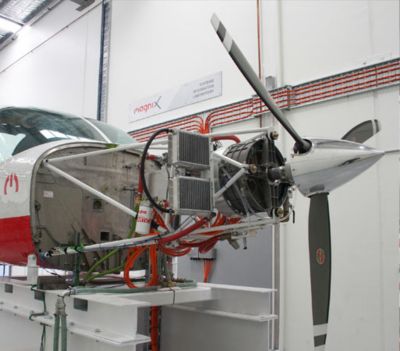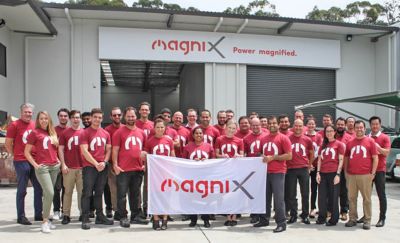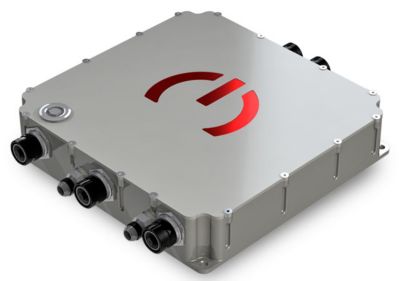-
-
学生向け無料ソフトウェアにアクセス
Ansysは次世代の技術者を支援します
学生は、世界クラスのシミュレーションソフトウェアに無料でアクセスできます。
-
今すぐAnsysに接続!
未来をデザインする
Ansysに接続して、シミュレーションが次のブレークスルーにどのように貢献できるかを確認してください。
国および地域
無料トライアル
製品およびサービス
リソースとトレーニング
当社について
Back
製品およびサービス
ANSYS ADVANTAGE MAGAZINE
DATE: 2020
Connecting the World with Middle-Mile, Electric Powered Flights
Ansys Dimensions Staff

The first era of the jet age began in the 1930s, when jet-powered aircraft took to the skies. These engines relied on thrust generated by burning hydrocarbon fuels to carry passengers in comfort. After more than 80 years of incremental innovations in the field, magniX is now planning to revolutionize the industry and launch the next era of aviation by developing electric propulsion for aircraft to carry up to 20 passengers — or a combination of passengers and cargo — as far as 650 miles with no exhaust emissions. This will create a new market for clean, inexpensive, middle-mile commercial passenger and cargo flights. Dimensions recently spoke with Roei Ganzarski, CEO of magniX, to learn how the company is solving the electrically powered aircraft challenge while redefining the concept of “connectivity.”
Dimensions: What is your primary goal at magniX?
Roei Ganzarski: Our goal is to enhance prosperity by connecting communities with clean, low-cost electric aviation. To do this, we are developing innovative electric propulsion solutions for commercial aviation.
D: The concept of connecting communities is interesting, given that today “connectivity” has come to be associated more with wireless communications technology. What part does aviation play?
RG: Obviously, all major cities are already connected by large airlines. But when you look at subcommunities — medium-sized or smaller cities, towns, rural areas — there are few low-cost, efficient air connections or rail connections (particularly in the U.S.) because it is not economical. So if someone wants to fly, they may need to drive — many times for hours — just to get to an airport. This limits the movement of people and goods, which in turn limits economic growth and prosperity.
Electric aviation will provide a very clean, low-cost mode of transport between small and medium-sized cities, which means that now you can redefine a “suburb” as a town that is maybe a 40-minute flight away versus a 40-minute drive away. Suddenly a small company in a small town can export their products to other larger cities and grow. They grow, they hire more people, the economy gets better, prosperity goes up. That is what magniX is all about.

A magniX engineer performs electric propulsion testing.
D: Electrification has been applied to the automotive and industrial sectors, but we have not heard much about electric propulsion of airplanes. Why did you decide to bring electrification to the aerospace industry?
RG: We selected commercial aviation to focus on because of the tremendous prosperity effects it can bring. For distances of less than 50 miles, we have plenty of alternatives such as cars, buses, subways, etc. While they may not be the most efficient or clean, they offer service. For distances above 1,000 miles, today’s aviation industry provides an efficient and reasonably priced solution.
For distances between 50 and 1,000 miles, there is no good, clean, economical solution that provides value. In many cases, the only mode of transport available is driving for hours. With that said, the airport infrastructure, especially in places like the United States, is extensive. So, an electric aviation solution offers increased connectivity while not requiring tremendous investments in infrastructure — like high-speed rail, for example, would require in laying tracks across vast distances.
Even with today’s battery technology, we can do short flights — 100 miles in a retrofitted aircraft and 650 miles in an aircraft designed from the start for electric propulsion. But to put that in perspective, 5% of worldwide airline flights in 2018 were less than 100 miles, and 45% were less than 500 miles. These numbers do not even include cargo flights. So there is clearly a need for these ranges. Why not have them be electric? Why not have them be clean and reduce the 4% of emissions worldwide generated by aviation (12% here in the U.S.)?
The key elements for aerospace motors are weight, power, efficiency and reliability.

A magniX electric motor on a Cessna “iron bird” test rig.

Roei Ganzarski
CEO, Magnix
D: What has been your biggest engineering challenge in developing electric propulsion for aerospace applications?
RG: The key elements for aerospace motors are weight, power, efficiency and reliability. We have been able to develop motors that are more powerful and lighter than anything else out there, with levels of reliability and redundancy we have come to expect in aviation. Moreover, the motors rotate at very low speeds. This low speed is very important. If you take, for example, a traditional middle-mile aircraft, the propellers turn at about 1,900 rpm but their turbine or piston engines turn at multiple times that. So you need a heavy gearbox between these elements to match the speeds. We eliminated the heavy gearbox. Our motor turns at 1,900 rpm — the same speed as the propeller — producing the same power level that the traditional internal combustion engines create. That means that we can connect the propeller directly to the motor, eliminating the weight and the maintenance elements of that gearbox.
D: What role did engineering simulation play in this innovation?
RG: Simulation is a critical aspect of our development at magniX. We are doing something that no one has ever done before. We can’t look around in the literature or at other companies and say, “Hey, show me what you’ve done, and I’ll do the same thing.”
So, there were two ways to approach this challenge. We could start building motors, trying them out and learning — the way it used to be done — or we could take advantage of phenomenal simulation technology that allows us to try out different ideas before we actually “turn metal,” to use the old manufacturing terminology.
Simulation allows us to try out different ideas, from fluid dynamics to stress to structural properties to electromagnetics in a multiphysics environment to take into consideration all the simultaneous forces at play when an electric motor is working. We can do this virtually, on the computer, before ever creating the actual first article in hardware. Simulation helps to increase the speed in which we can go to market. If we had to build every motor design to test each one, it would take us years before we ever had anything to even try on the ground, let alone in the air. When you are revolutionizing an industry like we are, time is of the essence.
D: What led you to choose ANSYS simulation solutions?
RG: When we looked around, we noticed that Ansys simulation is being used by many other aerospace companies. So we knew that the tool itself has been proven and has been used successfully within aerospace.
Because of the high level of safety necessary in the aerospace industry, you must have levels of simulation that the regulating authorities will approve. We must pass every single test that the FAA, EASA, Transport Canada and every other regulatory body in the world puts us through, and we expect to pass every test with flying colors. By using embedded software development tools from Ansys for the control code in our motors, we have the utmost confidence that our qualification efforts will be streamlined, allowing us to get to market faster.
We have to have confidence that our partners, our suppliers, our customers and the regulatory authorities can look at our data and say: “We know that simulation model, we understand that what it represents is as close as possible to what is happening in reality and we’ll accept the results it generates.” There are very few companies in the world with the level of modeling and simulation that meet these high standards, and Ansys was the choice for us.

D: How has using simulation benefited magniX?
RG: The biggest value that we’re getting from Ansys solutions is time and money. What using Ansys simulations allows us to do, more than anything, is rule out ideas that would cost us a lot of money and time later on. Simulations can tell us upfront, “It is not going to work, or it is just not going to give you the results that you want.”
When you are leading a revolution, like we are doing by electrifying an industry that hasn’t really changed for over 80 years, you have to be first to market to make a real change and lead the way. Ansys helps us to be first to market.
D: What makes magniX different?
RG: It is all about our team. We do not want them to think outside the box — they should simply not see a box. So, when you bring that attitude to bear on the challenge of electric commercial aviation, they can say, “OK, what do we need to do to get there?” versus the traditional approach, which is to look at what we have today and determine what can we do to improve it incrementally. It is a very different approach. As a small company dedicated to commercial electric aviation, we can allow ourselves to follow this different approach and do it very quickly. Our team is bringing back the same level of dreaming, focus and questioning of status quo that propelled aviation in the '20s and '30s and got lost along the way.
As I said, magniX is not about the electric motor itself. Rather, it is about how the motor can connect communities with clean, low-cost air transportation, because if you do that, you open the door to the movement of people and goods like never before — that is really the end game.
AN INNOVATIVE HISTORY

A magniDrive, which controls the company's motors.
| Number of employees: | 60 |
| Headquarters: | Redmond, WA |